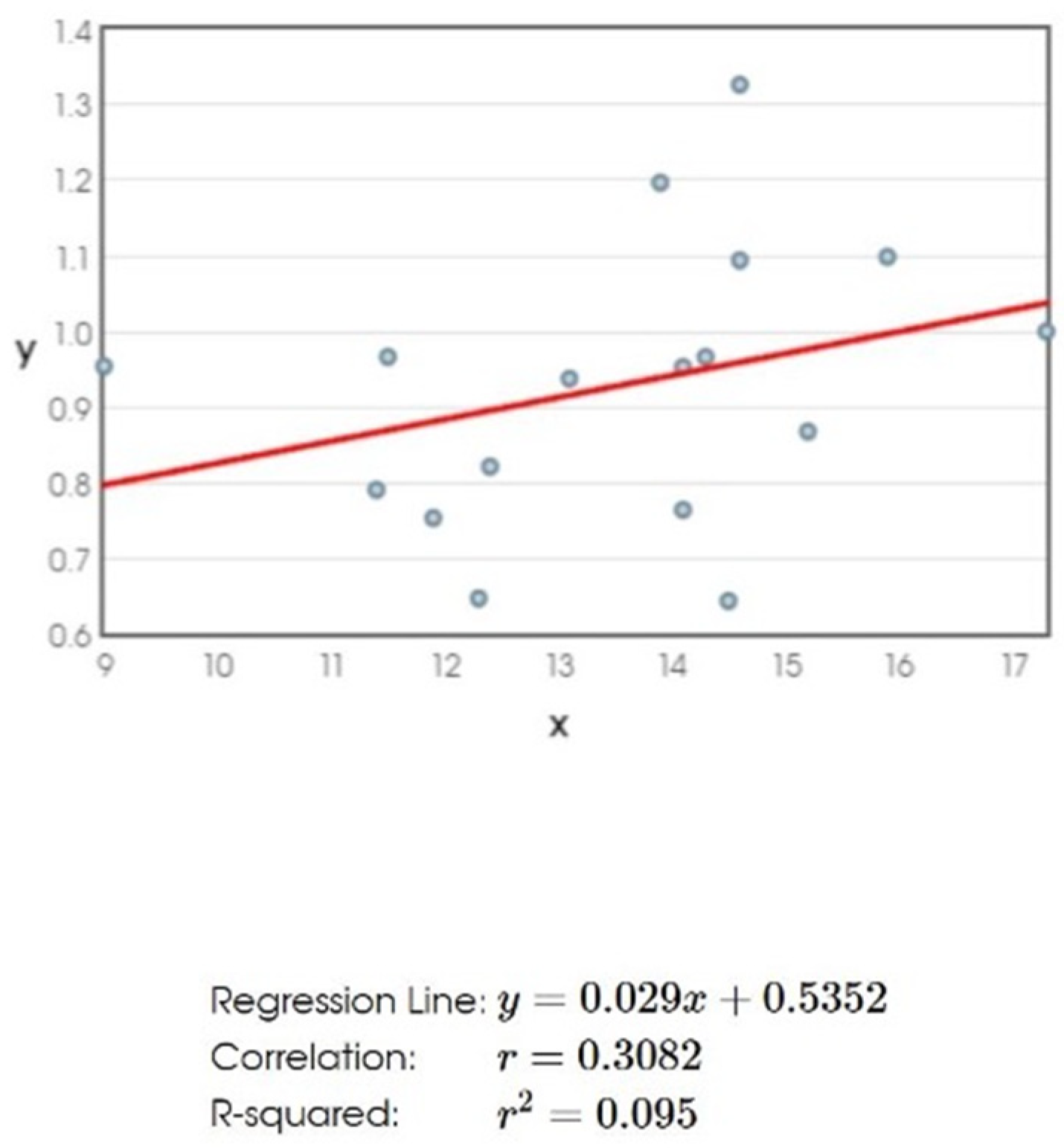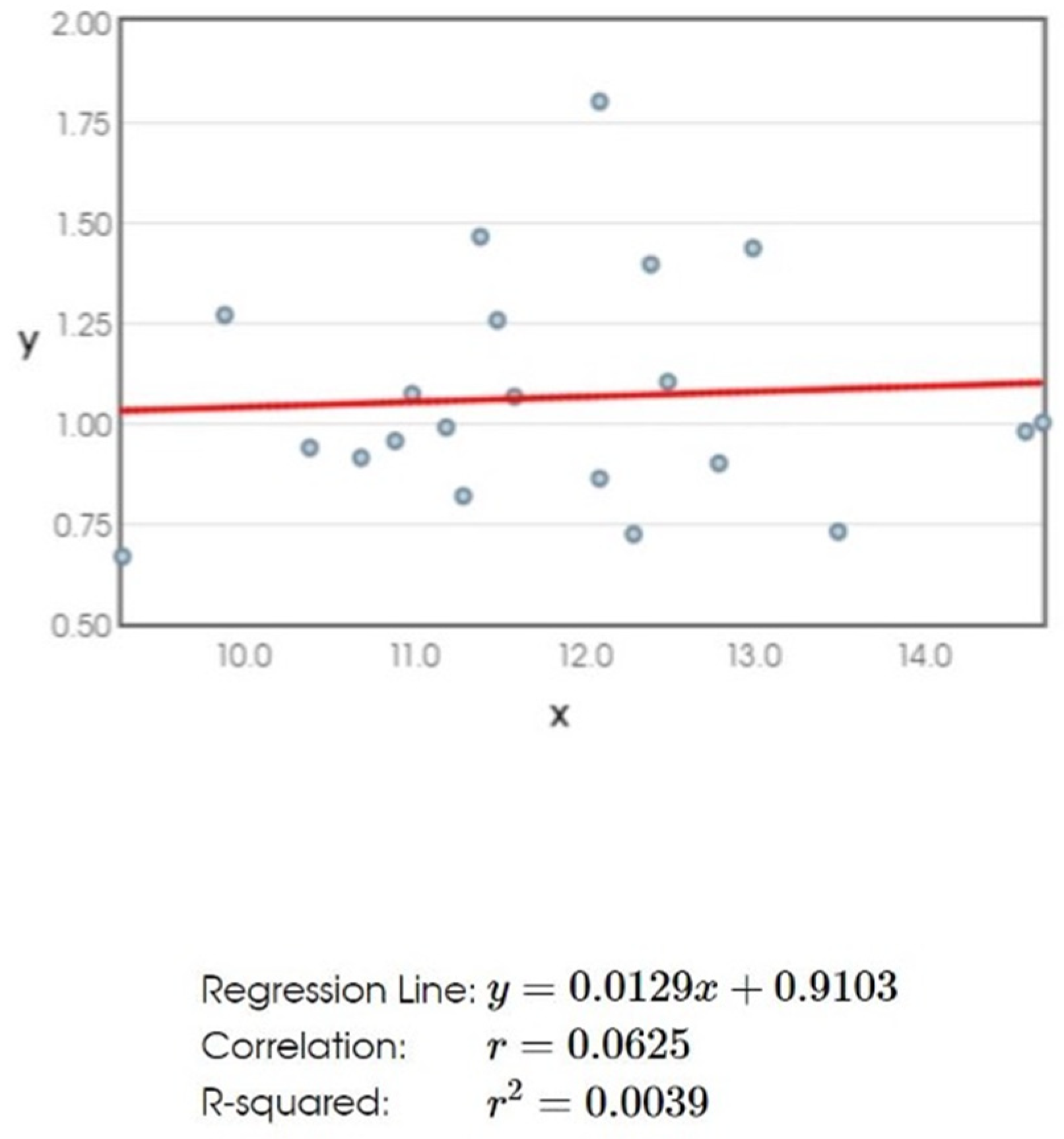Soft Tissue Movement in Orthognathic Surgery: Does Pre-Operative Soft Tissue Thickness Affect Movement Change?
Abstract
:1. Introduction
2. Materials and Methods
2.1. Definition of Study Sample
2.2. Definition of Variables
2.3. Research Methods
- Patients after maxillary surgery—A postop-A preop distance;
- Patients after mandibular surgery—B postop-B preop distance;
- Patients after chin surgery—Pog postop-Pog preop distance;
- Soft tissue Changes were measured in the same way: A’ postop–A’ preop distance; B’ postop–B’ preop distance; and Pog’ postop–Pog’ preop distance;
- Preoperative soft tissue thickness was measured on preoperative X-ray (A-A’, B-B’, Pog-Pog’—Figure 1).
2.4. Statistical Analysis
3. Results
4. Discussion
- Some of the performed surgeries involved more than one jaw. This creates a situation in which we check similar movements in different surgeries that may affect the outcome—it is known that one jaw surgery might affect ST of the other. Further research in larger sample groups would require stratification not only along direction of movements or the jaw moving, but also the type of surgery and other movements along the one that is being checked.
- We had a relatively small study group (cases with insufficient data were excluded) causing difficulty in reaching statistically significant results. This resulted in dealing with trends in present cases without performing a calculation of study samples.
- There is a limitation in the ability to check the relation between hard and soft tissue movements in lateral cephalometric X-ray due to several factors: complex anatomical structures, superimposition of two images, image sharpness and quality, and the ability of the researcher to mark accurately the reference points.
- Selection bias—only fully documented cases were selected; it is not known whether other operated cases may have changed the results.
5. Conclusions
Author Contributions
Funding
Institutional Review Board Statement
Informed Consent Statement
Data Availability Statement
Conflicts of Interest
References
- Chew, M.T.; Sandham, A.; Wong, H.B. Evaluation of the Linearity of Soft- to Hard-Tissue Movement after Orthognathic Surgery. Am. J. Orthod. Dentofac. Orthop. 2008, 134, 665–670. [Google Scholar] [CrossRef] [PubMed]
- Olate, S.; Zaror, C.; Blythe, J.N.; Mommaerts, M.Y. A Systematic Review of Soft-to-Hard Tissue Ratios in Orthognathic Surgery. Part III: Double Jaw Surgery Procedures. J. Cranio-Maxillofac. Surg. 2016, 44, 1599–1606. [Google Scholar] [CrossRef] [PubMed]
- Bailey, L.J.; Collie, F.M.; White, R.P.J. Long-Term Soft Tissue Changes after Orthognathic Surgery. Int. J. Adult Orthodon. Orthognath. Surg. 1996, 11, 7–18. [Google Scholar] [PubMed]
- McFarlane, R.B.; Frydman, W.L.; McCabe, S.B.; Mamandras, A.M. Identification of Nasal Morphologic Features That Indicate Susceptibility to Nasal Tip Deflection with the LeFort I Osteotomy. Am. J. Orthod. Dentofac. Orthop. 1995, 107, 259–267. [Google Scholar] [CrossRef]
- Miguel, J.A.M.; Palomares, N.B.; Feu, D. Life-Quality of Orthognathic Surgery Patients: The Search for an Integral Diagnosis. Dent. Press J. Orthod 2014, 19, 123–137. [Google Scholar] [CrossRef]
- Subtelny, J.D. A Longitudinal Study of Soft Tissue Facial Structures and Their Profile Characteristics, Defined in Relation to Underlying Skeletal Structures. Am. J. Orthod. 1959, 45, 481–507. [Google Scholar] [CrossRef]
- San Miguel Moragas, J.; Van Cauteren, W.; Mommaerts, M.Y. A Systematic Review on Soft-to-Hard Tissue Ratios in Orthognathic Surgery Part I: Maxillary Repositioning Osteotomy. J. Cranio-Maxillofac. Surg. 2014, 42, 1341–1351. [Google Scholar] [CrossRef]
- San Miguel Moragas, J.; Oth, O.; Büttner, M.; Mommaerts, M.Y. A Systematic Review on Soft-to-Hard Tissue Ratios in Orthognathic Surgery Part II: Chin Procedures. J. Cranio-Maxillofac. Surg. 2015, 43, 1530–1540. [Google Scholar] [CrossRef]
- Ohba, S.; Kohara, H.; Koga, T.; Kawasaki, T.; Miura, K.I.; Yoshida, N.; Asahina, I. Soft Tissue Changes after a Mandibular Osteotomy for Symmetric Skeletal Class III Malocclusion. Odontology 2017, 105, 375–381. [Google Scholar] [CrossRef]
- Burstone, C.J. The Integumental Profile. Am. J. Orthod. 1958, 44, 1–25. [Google Scholar] [CrossRef]
- Abeltins, A.; Jakobsone, G. Soft Tissue Thickness Changes after Correcting Class III Malocclusion with Bimaxillar Surgery. Stomatologija 2011, 13, 87–91. [Google Scholar] [PubMed]
- Yeo, B.-Y.; Kim, J.-S.; Kim, J.; Kim, J.-Y.; Jang, W.-W.; Kang, Y.-G. Submandibular Soft Tissue Changes after Mandibular Set-Back Surgery in Skeletal Class III Patients. J. Stomatol. Oral Maxillofac. Surg. 2019, 120, 301–309. [Google Scholar] [CrossRef] [PubMed]
- Kolokitha, O.-E.; Topouzelis, N. Cephalometric Methods of Prediction in Orthognathic Surgery. J. Maxillofac. Oral Surg. 2011, 10, 236–245. [Google Scholar] [CrossRef] [PubMed]
- Wolford, L.M.; Hilliard, F.W.; Dugan, D.J. Surgical Treatment Objective: A Systematic Approach to the Prediction Tracing; CV Mosby: Maryland Heights, MO, USA, 1985. [Google Scholar]
- Kolokitha, O.E.; Chatzistavrou, E. Factors Influencing the Accuracy of Cephalometric Prediction of Soft Tissue Profile Changes Following Orthognathic Surgery. J. Maxillofac. Oral Surg. 2012, 11, 82–90. [Google Scholar] [CrossRef]
- Van Twisk, P.-H.; Tenhagen, M.; Gül, A.; Wolvius, E.; Koudstaal, M. How Accurate Is the Soft Tissue Prediction of Dolphin Imaging for Orthognathic Surgery? Int. Orthod. 2019, 17, 488–496. [Google Scholar] [CrossRef]
- Olate, S.; Zaror, C.; Mommaerts, M. A Systematic Review of Soft-to-Hard Tissue Ratios in Orthognathic Surgery. Part IV: 3D Analysis-Is There Evidence? J. Cranio-Maxillofac. Surg. 2017, 45, 1278–1286. [Google Scholar] [CrossRef]
- Stella, J.P.; Streater, M.R.; Epker, B.N.; Sinn, D.P. Predictability of Upper Lip Soft Tissue Changes with Maxillary Advancement. J. Oral Maxillofac. Surg. 1989, 47, 697–703. [Google Scholar] [CrossRef]
- Freihofer, H.P.M. Changes in Nasal Profile after Maxillary Advancement in Cleft and Non-Cleft Patients. J. Maxillofac. Surg. 1977, 5, 20–27. [Google Scholar] [CrossRef]
- Gjørup, H.; Athanasiou, A.E. Soft-Tissue and Dentoskeletal Profile Changes Associated with Mandibular Setback Osteotomy. Am. J. Orthod. Dentofac. Orthop. 1991, 100, 312–323. [Google Scholar] [CrossRef]
- Chunmaneechote, P.; Friede, H. Mandibular Setback Osteotomy: Facial Soft Tissue Behavior and Possibility to Improve the Accuracy of the Soft Tissue Profile Prediction with the Use of a Computerized Cephalometric Program: Quick Ceph Image Pro: V. 2.5. Clin. Orthod Res. 1999, 2, 85–98. [Google Scholar] [CrossRef]
- Joss, C.U.; Joss-Vassalli, I.M.; Berg, S.J.; Kuijpers-Jagtman, A.M. Soft Tissue Profile Changes after Bilateral Sagittal Split Osteotomy for Mandibular Setback: A Systematic Review. J. Oral Maxillofac. Surg. 2010, 68, 2792–2801. [Google Scholar] [CrossRef] [PubMed]





| N | Mean (+SD) | p Value (t-Test) | |
|---|---|---|---|
| Preoperative soft tissue thickness upper lip (A-A’—mm) | 33 | 13.79 + 2.37 | |
| Preoperative soft tissue thickness upper lip—<5 mm advancement (A-A’—mm) | 16 | 14.06 + 2.77 | 0.53 |
| Preoperative soft tissue thickness upper lip—>5 mm advancement (A-A’—mm) | 17 | 13.53 + 1.97 | |
| Preoperative soft tissue thickness lower lip (B-B’—mm) | 35 | 11.23 + 1.6 | |
| Preoperative soft tissue thickness lower lip—setback cases (B-B’—mm) | 21 | 11.75 + 1.46 | 0.006 |
| Preoperative soft tissue thickness lower lip—advancement cases (B-B’—mm) | 14 | 10.28 + 1.46 | |
| Preoperative soft tissue thickness upper lip (Pog-Pog’—mm) | 6 | 11.8 + 2.44 |
| Mean (+SD) | |
|---|---|
| Maxillary AP advancement (N = 33, mm) | 5.55 + 2.12 |
| Mandibular AP advancement (N = 14 mm) | 5.96 + 2.42 |
| Mandibular AP setback (N = 21 mm) | −6.21 + 2.52 |
| Chin AP advancement (N = 6 mm) | 6.02 + 3.2 |
| Type | Count | % |
|---|---|---|
| Bi-Maxillary (Two Jaws) | 24 | 57.1% |
| Bi-Maxillary and chin | 4 | 9.5% |
| Maxilla only | 5 | 11.9% |
| Maxilla and chin | 1 | 2.4% |
| Mandible only | 7 | 16.7% |
| Mandible and chin | 1 | 2.4% |
| Total | 42 | 100.0% |
Publisher’s Note: MDPI stays neutral with regard to jurisdictional claims in published maps and institutional affiliations. |
© 2022 by the authors. Licensee MDPI, Basel, Switzerland. This article is an open access article distributed under the terms and conditions of the Creative Commons Attribution (CC BY) license (https://creativecommons.org/licenses/by/4.0/).
Share and Cite
Joachim, M.V.; Brosh, Y.; Daoud, F.; Abdelraziq, M.; Abu El-Naaj, I.; Laviv, A. Soft Tissue Movement in Orthognathic Surgery: Does Pre-Operative Soft Tissue Thickness Affect Movement Change? Appl. Sci. 2022, 12, 8170. https://doi.org/10.3390/app12168170
Joachim MV, Brosh Y, Daoud F, Abdelraziq M, Abu El-Naaj I, Laviv A. Soft Tissue Movement in Orthognathic Surgery: Does Pre-Operative Soft Tissue Thickness Affect Movement Change? Applied Sciences. 2022; 12(16):8170. https://doi.org/10.3390/app12168170
Chicago/Turabian StyleJoachim, Michael V., Yair Brosh, Fadi Daoud, Murad Abdelraziq, Imad Abu El-Naaj, and Amir Laviv. 2022. "Soft Tissue Movement in Orthognathic Surgery: Does Pre-Operative Soft Tissue Thickness Affect Movement Change?" Applied Sciences 12, no. 16: 8170. https://doi.org/10.3390/app12168170
APA StyleJoachim, M. V., Brosh, Y., Daoud, F., Abdelraziq, M., Abu El-Naaj, I., & Laviv, A. (2022). Soft Tissue Movement in Orthognathic Surgery: Does Pre-Operative Soft Tissue Thickness Affect Movement Change? Applied Sciences, 12(16), 8170. https://doi.org/10.3390/app12168170






